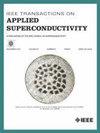The Bending Performance Study of Bridge-Type Butt Joint of REBCO Tapes
IF 1.7
3区 物理与天体物理
Q3 ENGINEERING, ELECTRICAL & ELECTRONIC
引用次数: 0
Abstract
To meet the magnetic field design requirements of a new detector for the Circular Electron Positron Collider, a novel aluminum-stabilized stacked rare-earth barium copper oxide (REBCO) tape cable has been proposed and developed. Bridge-type butt joints are utilized to interconnect the REBCO tapes within the cable for the production of kilometer-scale cables. In this investigation, bridge-type butt joints of the REBCO tape were fabricated using soldering techniques, and their bending performance under various bending diameters at 77 K and self-field conditions was examined through finite-element analysis and bending tests. The simulation and experimental results showed a gradual degradation in the critical current (桥式REBCO胶带对接接头的弯曲性能研究
为了满足环形正电子对撞机新型探测器的磁场设计要求,提出并研制了一种新型铝稳定叠稀土钡氧化铜(REBCO)带缆。桥式对接接头用于连接电缆内的REBCO胶带,用于生产公里级电缆。采用焊接技术制备了REBCO带的桥式对接接头,并通过有限元分析和弯曲试验考察了REBCO带在不同弯曲直径和77 K自场条件下的弯曲性能。仿真和实验结果表明,桥式对接接头在弯曲应变作用下的临界电流Ic逐渐降低。通过将接头间隙置于下侧并增大接头间隙,提高了弯曲性能。当间隙距离为10mm时,临界弯曲半径阈值可能在25 ~ 20mm之间。有限元分析显示,当等效应变超过0.4%时,Ic会出现明显的退化,这表明弯曲过程中应力分布不均匀,导致局部区域应力水平升高,可能导致潜在的损伤和退化。
本文章由计算机程序翻译,如有差异,请以英文原文为准。
求助全文
约1分钟内获得全文
求助全文
来源期刊

IEEE Transactions on Applied Superconductivity
工程技术-工程:电子与电气
CiteScore
3.50
自引率
33.30%
发文量
650
审稿时长
2.3 months
期刊介绍:
IEEE Transactions on Applied Superconductivity (TAS) contains articles on the applications of superconductivity and other relevant technology. Electronic applications include analog and digital circuits employing thin films and active devices such as Josephson junctions. Large scale applications include magnets for power applications such as motors and generators, for magnetic resonance, for accelerators, and cable applications such as power transmission.
 求助内容:
求助内容: 应助结果提醒方式:
应助结果提醒方式:


